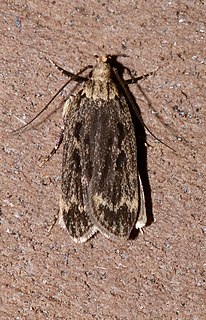Frisilia is a genus of moths in the family Lecithoceridae. The genus was erected by Francis Walker in 1864.
Agonopterix taciturna is a moth in the family Depressariidae. It was described by Edward Meyrick in 1910. It is found in the Himalayas, the Russian Far East and Japan.
Narthecoceros logica is a moth in the family Gelechiidae. It was described by Edward Meyrick in 1910. It is found in Sri Lanka.
Frisilia compsostoma is a moth in the family Lecithoceridae. It was described by Edward Meyrick in 1921. It is found in the Democratic Republic of the Congo's former Katanga Province and in Zimbabwe.
Frisilia melanardis is a moth in the family Lecithoceridae. It was described by Edward Meyrick in 1910. It is found on Borneo.
Frisilia procentra is a moth in the family Lecithoceridae. It was described by Edward Meyrick in 1916. It is found in southern India.
Frisilia senilis is a moth in the family Lecithoceridae. It was described by Edward Meyrick in 1910. It is found in southern India.
Frisilia strepsiptila is a moth in the family Lecithoceridae. It was described by Edward Meyrick in 1910. It is found in southern India.
Frisilia sulcata is a moth in the family Lecithoceridae. It was described by Edward Meyrick in 1910. It is found in Nepal and Assam, India.
Frisilia verticosa is a moth in the family Lecithoceridae. It was described by Edward Meyrick in 1914. It is found in southern India.
Frisilia notifica is a moth in the family Lecithoceridae. It was described by Edward Meyrick in 1910. It is found in Sri Lanka.
Frisilia sejuncta is a moth in the family Lecithoceridae. It was described by Edward Meyrick in 1929. It is found in southern India and Sri Lanka.
Frisilia triturata is a moth in the family Lecithoceridae. It was described by Edward Meyrick in 1914. It is found in the Democratic Republic of the Congo and Malawi.
Frisilia homochlora is a moth in the family Lecithoceridae. It was described by Edward Meyrick in 1910. It is found in southern India and Jiangxi, China.
Spatulignatha hemichrysa is a moth in the family Lecithoceridae. It was described by Edward Meyrick in 1910. It is found in Assam, India.
Lecithocera autologa is a moth in the family Lecithoceridae. It was described by Edward Meyrick in 1910. It is found in Sri Lanka.
Lecithocera fausta is a moth in the family Lecithoceridae. It was described by Edward Meyrick in 1910. It is found on Luzon in the Philippines.
Lecithocera itrinea is a moth in the family Lecithoceridae. It was described by Edward Meyrick in 1910. It is found in Sri Lanka and southern India.
Deltoplastis byssina is a moth in the family Lecithoceridae. It was described by Edward Meyrick in 1910. It is found in Sri Lanka.

Martyringa xeraula, the Himalayan grain moth, is a moth in the family Lecithoceridae. It was described by Edward Meyrick in 1910. It is found in India (Assam), western China, Japan and North America, where it has been recorded from Louisiana, Texas and from Florida to South Carolina.
